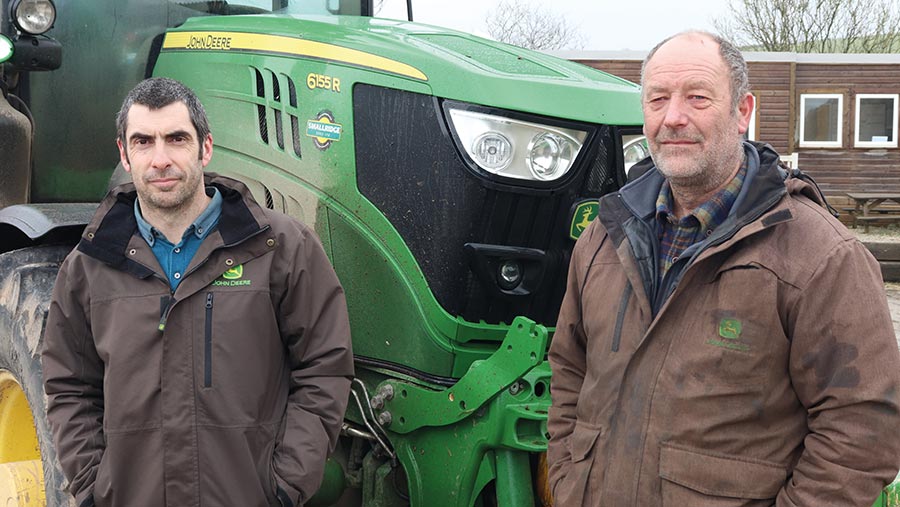8 new tractors arrive as A&B Contractors updates fleet
 Richard Barrow and Andrew Patt © Andrew Faulkner
Richard Barrow and Andrew Patt © Andrew Faulkner In our new contractor series, we pay regular visits to four contracting firms located in different regions of the UK.
First up is our South West contractor – Devon-based A&B Contractors – owned by Richard Barrow and Tony Dallyn, and jointly managed by Richard Barrow and Andrew Patt.
We catch up with them while they prepare for a challenging season.
See also: Business Clinic: What insurance is needed to do contracting?
Business facts: A&B Contractors, Porte Farm, Kentisbury, Devon
- Main services Contract farming supplying home-grown maize, wholecrop, cereals and straw; 3,850ha grass silage; 485ha wholecrop silage; 365ha maize drilling and harvesting; 570ha combining; 30,000 round bales; 9,500 square bales; ploughing and drilling; shoot plot establishment, maintenance and aftercare; umbilical slurry injecting/spreading with nurse tank; muck and biosolids spreading; vacuum tanking with dribble bar
- Other Eight-strong haulage fleet; concrete and groundwork services; timber processing and harvesting
- Staff 23 full-time on the ag business, up to 60 during seasonal peaks
About the contractor

From its base in Kentisbury, Devon, Richard Barrow’s A&B Contractors offers the full range of agricultural services, haulage and groundworks
How did you get into contracting?
Richard Barrow: I started out working for my godfather, who was a contractor in the mid-1980s.
Sadly, he died in a tractor accident in 1988, so I eventually decided to set up on my own, based on my parents’ 36ha farm.
I borrowed money from my gran to buy a tractor and hedge trimmer, and before long I’d assembled a small fleet of John Deeres and assorted grass kit.
The business was built on the baling and wrapping of grass, which took off in the 1990s. Average annual bale count back then was about 27,000 bales, whereas today it’s nearer 39,000 rounds and squares.
The difference is that we’re now also clamping 4,700ha of grass, wholecrop and maize.
Main contracting enterprises?
We offer grass and arable services to livestock/mixed farms in North Devon, North Cornwall, Exmoor and West Somerset, predominantly in a 50-mile radius of Barnstaple.
Average field size is about 4ha, although there are some larger areas up on Exmoor, and we do also carry out work for specialist arable units.
On field size, last year we ended up chopping about 50ha of grass in one day in more than 30 different fields for one customer. That’s challenging, in terms of output, hassle and cost.
Typically, our year kicks off with spring ploughing and drilling, and from 1 February we’re busy on slurry and umbilical work, as most of our customers are in a nitrate vulnerable zone.
Solid and liquid fertiliser applications are next on the list, ahead of multiple cuts of clamp silage for dairy farmers from late April right through the season.
The foragers will do one or two big grass cuts for beef/sheep farmers on Exmoor in August/September, followed by wholecrop and maize across our whole operating area.
Round/square baling and wrapping starts in May and runs through until October/November.
On the arable side, we offer most services and also rent about 200ha on an annual basis. This rented area varies according to how much land can be can spared by stock farmers in a particular grass season.

Pottinger combi drill © Andrew Patt
Any forms of diversification?
Transport and groundworks are the two main areas of diversification, as well as the letting out of buildings.
Yard space – workshops, office, machinery storage, aggregate/timber storage – has now grown to cover about 4ha of the original 36ha farm.
The transport division employs six staff and runs eight wagons: 7.5t rigids up to 44t artics with flatbed, bulk and lowloader trailers.
Cargo is mixed, including straw, hay, miscanthus and bedding sand, while the lowloaders haul both the firm’s own kit and for third parties.
In 2022, the trucks carted multiple loads of silage up country to other drought-impacted stock farmers.
Groundworks and timber processing/harvesting provide work for another 10 people.
It’s a mixed workload – from preparing sites for the construction of houses and industrial/farm buildings to land drainage and operating a tree shear on a 13t swing shovel.
The ag contracting division comprises further 23 full-time staff (up to 45 in the summer), and we’ve diversified here, too.
We’re running a JCB Fastrac 4220 and 11,000-litre vacuum tanker for South West Water, emptying septic tanks on sites not accessible to trucks.
For South West Water, we use 10t Teagle rear-discharge spreaders to apply biosolids.
Last up, we’ve seen a big increase in the demand from farmers for establishing wild bird and pollen and nectar plots.
Most profitable contracting enterprise?
How profitable an enterprise is tends to be very weather dependent. For example, road gritting for local authorities can be busy in a cold winter.
We operate a fleet of eight modified gritters and can treat up to 160 sites in a night. The only problem is that the workload clearly varies from year to year and in a warm wet winter it’s pretty fruitless.
The most profitable enterprise in our history is the construction and regular relocation of temporary training compounds for the army on Salisbury Plain between 2010 and 2015.
Least profitable contracting enterprise?
Umbilical slurry work. It’s a service that we have to provide, as it’s much more efficient than using tankers.
But the ongoing costs are horrendous, with bedding sand effectively acting like a grinding paste in pumps and pipework.
We’ve just had to spend £7,500 on 400m of new pipe, and it’s not unusual to receive bills of £10,000 for umbilical kit rebuilds.
At £120-£130/hour, the charge rate struggles to justify the expense, but the job is very competitive in this area.
Biggest threats to your business?
The escalating costs of all major inputs such as diesel, fertiliser, seed, machinery and wages.
Ideally, we’d increase our charge rates to customers to cover this, but then they’re also facing the gradual disappearance of the Basic Payment Scheme and a drop in their milk price. It’s a challenging time for everyone.
Machinery prices have gone crazy, too. It’s not so long ago that we were paying £50,000-£60,000 for a tractor that now costs £150,000.
As for fuel? In 2021, we averaged about 59p/litre, whereas last harvest it went up to £1.10. It’s now slipped back to about 90p, but continually fluctuates.
When you’re buying 30,000 litres/week in peak periods, these fluctuations have a massive impact on the business.
Difficulties with staff recruitment?
Staffing levels an ongoing concern, because we need to employ up to 60 people across the whole operation during busy periods.
We use Facebook and Indeed to find new people, though ‘word of mouth’ is the most reliable method.
Everyone thinks they can drive a tractor but, unless they’ve grown up on a farm or are already in the industry, they generally struggle with the size, speed and sophistication of modern kit.
On top of that, in North Devon we operate on some pretty steep slopes, which can be intimidating if you’re not familiar with them.
What excites you about the season ahead?
A bit of normality would be good. We may have had an easy cereal harvest in 2022, but the drought was a disaster for many grass farmers. Bale count was dramatically down.

© Luke Larson
New machines in 2023?
There is just the one tractor arriving in 2023, a John Deere 6R 215, ordered in January 2022 and due for delivery this spring.
Last year, we swapped in seven JD 6155Rs for the same and one 6195R. Before that, we changed seven Valtras for either Deeres or New Hollands.
We liked the Valtras but had issues with them breaking down and repair times.
There is no fixed replacement policy, other than ensuring all tractors are moved on before the end of their three-year/6,000-hour warranty.
With most repairs over £1,000 and occasionally over £10,000, we wouldn’t sleep at night with 20-plus tractors out of warranty and potentially at risk. Finance is a mix of hire purchase and lease.
The longer lead times on new machine supply are a pain, but can be factored in. Where it gets tricky is if the part-ex goes down while we’re waiting.
For example, we had an outgoing Fendt blow a gearbox just a few hours before it’s long-overdue Deere replacement turned up in the yard. Interesting conversations followed.
On other new kit, we’re waiting for a front/rear Amazone UF02 24m mounted sprayer combination, largely to handle the extra liquid fert work we’re taking on.
Recent major repairs/breakdowns?
The standout is a combine engine rebuild during harvest 2022. We bought the T550 second-hand, and it suffered from ongoing engine problems from the start.
The dealer had rebuilt the engine the previous winter, but then last summer it only managed about 40ha before dropping a valve in the middle of a customer’s field.
Fortunately, the harvester was only out of action for three or four days, and we were able to negotiate with the dealer over the £10,000 bill.
Overwinter projects?
There’s the already mentioned gritting work, and we also run three or four hedgecutters through the winter.
There’ll be four to six people on fencing work, plus there’s a lot of machines to go through in the workshop.
We’ll undertake larger workshop projects, too, such as mounting 5cu m ex-Devon County Council gritter bodies onto 7.5t commercial axles for towing behind a tractor.
Current contractor frustrations?
A level playing field would be good.
We’re charging around £50/hour for tractor, operator and fuel, which effectively breaks down to £20 on fuel and nearly £20 on the driver, including national insurance, tax, pension and holiday pay, etc.
That leaves just over £10 to cover depreciation, finance, repairs, servicing, tyres and insurance.
There’s not much money in that, yet we’re up against operators with older tractors and often sub-standard equipment sometimes charging as little as £35/hour.
Though not popular with many, we’d actually welcome requirements such as MOTs on tractors and trailers to raise overall standards, charge-out rates and ultimately the sustainability of the entire sector.
We’re doing our best to comply with requirements, but in many cases we’re hampered by a lack of guidance.
For our South West Water work, as an example, the JCB Fastrac runs on white diesel, is fitted with a tacho and is operated by a Class 1-qualified driver.
The tractor is subjected to six-weekly inspections, so it’s as close to truck spec as possible.
The tanker, on the other hand, is seemingly not covered by any laws and, at the moment, can’t be type approved, no matter where we take it. We want to comply but can’t.
Kit list
- Tractors John Deere 6215R, 6195R x3, 6155R x8, 6830, 6630, 6140M, 6130R with loader; New Holland T7210 x4; JCB Fastrac 4220
- Combines John Deere T550 x2
- Foragers John Deere 8600 and 7380i
- Forage wagons Pottinger Torro x2
- Handlers JCB 541-70, 536-60 and 531-70; Hyundai skid-steer
- Sprayers Bateman RB35 (36m/4,000-litre); Kuhn 24m and 12m mounted
- Drills 2.5m, 3m and 4m combination drills; Vaderstad 4m Rapid drill; Moore direct drill; Hatzenbichler 6m air seeder, Accord 12-row fodder beet drill; Kuhn eight-row maize drill; Accord six-row maize drill
- Diggers JCB 3CX; swing shovels x8 0.5t to 22t
- Main other kit Mower combination x3, square balers x3, round balers x4, rakes x4, wrappers, silage trailers x10, fertiliser spreaders x2, ploughs x4, slurry tankers x5, muckspreaders x10 and assorted umbilical equipment

